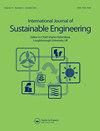Comparative LCA of conventional manufacturing vs. additive manufacturing: the case of injection moulding for recycled polymers
IF 3.6
Q3 GREEN & SUSTAINABLE SCIENCE & TECHNOLOGY
International Journal of Sustainable Engineering
Pub Date : 2021-10-17
DOI:10.1080/19397038.2021.1990435
引用次数: 6
Abstract
ABSTRACT Additive Manufacturing helps to develop production alternatives with new technologies and less environmental impacts. The comparative analysis was performed between two manufacturing processes using black recycled Acrylonitrile Butadiene Styrene (ABS) pellets to evaluate the potential environmental impacts between Injection moulding and Fused Deposition Modelling (FDM). The Life Cycle Assessment (LCA) and the Unit Process Life Cycle Inventory (UPLCI) methodology were adopted, which resulted in an impact assessment separated by operation modes and subunits of the equipment. The LCA results indicate a lower environmental impact of the FDM when the aim is to produce a batch size smaller than 14 parts. For batch sizes above 50 parts, the Injection moulding process generated less impact to the Global Warming Potential (GWP) and Cumulative Energy Demand (CED). The printing stage contributed the most to generating impacts for the FDM. In the Injection moulding process, the main responsible for generating impacts were the injection phase. Mechanical tensile tests were carried out with the parts obtained by the FDM with different infills (25%, 50%, 75% and 100%), and it was observed that parts with 100% infill obtained the best relation between mechanical properties and environmental impacts.传统制造与增材制造的LCA比较:回收聚合物注塑的案例
摘要增材制造有助于开发具有新技术和较少环境影响的生产替代品。使用黑色回收丙烯腈-丁二烯-苯乙烯(ABS)颗粒对两种制造工艺进行了比较分析,以评估注塑成型和熔融沉积建模(FDM)之间的潜在环境影响。采用了生命周期评估(LCA)和机组工艺生命周期清单(UPLCI)方法,这导致了按设备的运行模式和子单元进行的影响评估。LCA结果表明,当目标是生产小于14个零件的批量时,FDM对环境的影响较小。对于50个零件以上的批量,注塑工艺对全球变暖潜能值(GWP)和累计能源需求(CED)的影响较小。印刷阶段对FDM产生的影响最大。在注塑过程中,产生冲击的主要原因是注塑阶段。对FDM获得的具有不同填充物(25%、50%、75%和100%)的零件进行了机械拉伸试验,观察到具有100%填充物的零件获得了机械性能与环境影响之间的最佳关系。
本文章由计算机程序翻译,如有差异,请以英文原文为准。
求助全文
约1分钟内获得全文
求助全文
来源期刊

International Journal of Sustainable Engineering
GREEN & SUSTAINABLE SCIENCE & TECHNOLOGY-
CiteScore
7.70
自引率
0.00%
发文量
19
 求助内容:
求助内容: 应助结果提醒方式:
应助结果提醒方式:


